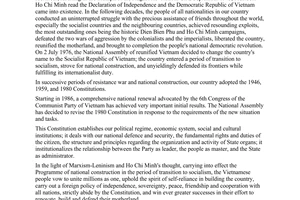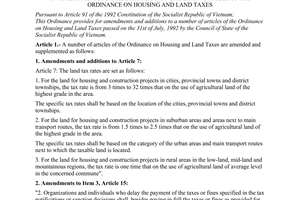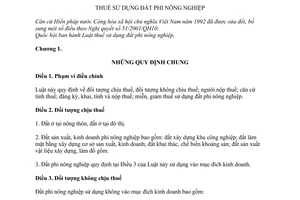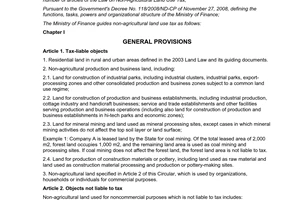Nội dung toàn văn Law No. 48/2010/QH12 on non-agricultural land use tax
|
THE
NATIONAL ASSEMBLY |
SOCIALIST
REPUBLIC OF VIET NAM |
|
No. 48/2010/QH12 |
|
LAW
ON NON-AGRICULTURAL LAND USE TAX
Pursuant to 1992 Constitution of the Socialist Republic of Vietnam, which was amended and supplemented under Resolution No. 51/2001/QH10; The National Assembly promulgates the Law on Non-Agricultural Land Use Tax.
Chapter I
GENERAL PROVISIONS
Article 1. Scope of regulation
This Law provides for objects liable or not liable to, payers of, bases for, registration, declaration, calculation and payment of, exemption from and reduction of, non-agricultural land use tax.
Article 2. Tax-liable objects
1. Residential land in rural and urban areas.
2. Non-agricultural production and business land, including land for the construction of industrial parks; land for the construction of production and business establishments; land for mineral exploitation and processing; and land for the production of construction materials and pottery articles. 3. Non-agricultural land specified in Article 3 of this Law which is used for commercial purposes.
Article 3. Objects not liable to tax
Non-agricultural land used for purposes other than commercial ones, including:
1. Land used for public purposes, including traffic and irrigation land, land for the construction of cultural, healthcare, education and training, and physical training and sports works for public interests; land with historicalcultural relics or scenic places; and land for the construction of other public works under the Government’s regulations;
2. Land used by religious institutions;
3. Land used for cemeteries and graveyards;
4. Land under rivers, canals, ditches, streams and special-use water surface;
5. Land with communal houses, temples, worship halls or clans’ worship houses;
6. Land for the construction of working offices or non-business works or for national defense and security purposes;
7. Other non-agricultural land provided for by law.
Article 4. Taxpayers
1. Taxpayers are organizations, households and individuals that have the right to use tax-liable land specified in Article 2 of this Law. 2. When organizations, households or indivi-duals have not yet been granted land use right certi-ficates or house and land-attached asset ownership certificates (below collectively referred to as certificates), current land users will be taxpayers.
3. Taxpayers in some cases are specified as follows:
a/ When land is leased by the State for the implementation of investment projects, lessees will be taxpayers;
b/ When persons having land use rights lease land under contracts, taxpayers shall be identified as agreed upon in these contracts. When no agreement on taxpayers is made in contracts, persons having land use rights will be taxpayers;
c/ When land has been granted a certificate but is currently under dispute, pending the dispute settlement, current land users will be taxpayers. Tax payment does not serve as a ground for the settlement of disputes over land use rights;
d/ When many persons have the right to co-use a land plot, the lawful representative of these co-users will be the taxpayer;
e/ When a person having land use rights contributes his/her land use rights as business capital, thereby forming a new legal entity that has the right to use tax-liable land specified in Article 2 of this Law, the new legal entity will be the taxpayer.
Chapter II
TAX BASES, REGISTRATION, DECLARATION, CALCULATION AND PAYMENT
Article 5. Tax bases
Tax bases are taxable price and tax rate.
Article 6. Taxable price
1. Taxable price of land is the taxable land area multiplied by the price of one square meter of land.
2. The taxable land area is specified as follows: a/ The taxable land area is the actually used land area.
When a person has the right to use many residential land plots, the taxable land area is the total area of taxable land plots.
When land is allocated or leased by the State for the construction of an industrial park, the taxable land area is exclusive of the land area for the construction of infrastructure facilities under common use;
b/ For residential land of a multi-story building with many users or a condominium with areas for both dwelling and commercial purposes, the taxable land area is the allocation coefficient multiplied by the area of the apartment of each user.
The allocation coefficient is the land area for the construction of a multistory building with many users or a condominium divided by the total area of apartments of users.
If a multi-story building with many users or a condominium has a basement, 50% of the basement area used by organizations, households and individuals shall be added to the total area of their apartments for calculating the allocation coefficient;
c/ For underground construction works, the applicable allocation coefficient is 0.5 of the constructed land area divided by the total area of works used by organizations, households and individuals. 3. The price of a square meter of land is the price of land based on its use purpose which is set by the provincial-level People’s Committee for a 5 year stabilization period from the effective date of this Law.
Article 7. Tax rates
1. Tax rates for residential land, including land used for commercial purposes, to be applied according to the Partially Progressive Tariff are specified as follows:
|
Tax grade |
Taxable land area (m2) |
Tax rate (%) |
|
1 |
Area within the set quota |
0.03 |
|
2 |
Area in excess of up to 3 times the set quota |
0.07 |
|
3 |
Area in excess of over 3 times the set quota |
0.15 |
2. The residential land quota used as a basis for tax calculation is the new quota of residential land allocation set by provincial-level People’s Committees from the effective date of this Law.
When residential land quotas have been set before the effective date of this Law, the following provisions shall be applied:
a/ When the residential land quota set before the effective date of this Law is lower than the new quota of residential land allocation, the new quota will be used as a basis for tax calculation;
b/ When the residential land quota set before the effective date of this Law is higher than the new quota of residential land allocation, the old quota will be used as a basis for tax calculation.
3. Residential land of multi-story buildings with many households, condominiums or underground construction works is subject to the tax rate of 0.03%.
4. Non-agricultural production and business land is subject to the tax rate of 0.03%.
5. Non-agricultural land specified in Article 3 of this Law which is used for commercial purposes is subject to the tax rate of 0.03%. 6. Land used for improper purposes or land not yet used under regulations is subject to the tax rate of 0.15%. Land of a phased investment project as registered by the investor and approved by a competent state agency will not be regarded as unused land and is subject to the tax rate of 0.03%. 7. Encroached or appropriated land is subject to the tax rate of 0.2% and has no applicable quota. Tax payment does not serve as a basis for recognizing taxpayers’ lawful land use rights for the encroached or appropriated land area.
Article 8. Tax registration, declaration, calculation and payment
1. Taxpayers shall register, declare, calculate and pay tax under the law on tax administration.
2. Taxpayers shall register, declare, calculate and pay tax at tax offices of rural districts, urban districts, towns or provincial cities in which they have land use rights.
Taxpayers in deep-lying or remote areas difficult to access may register, declare, calculate and pay tax at commune-level People’s Committees. Tax offices shall create conditions for taxpayers to fulfill their obligations.
3. When a taxpayer has the right to use many residential land plots, the taxable area is the total area of taxable residential-land plots within a province or centrally run city. Tax registration, declaration, calculation and payment are specified as follows:
a/ Taxpayers shall register, declare, calculate and pay tax at tax offices of rural districts, urban districts, towns or provincial cities in which they have land use rights;
b/ Taxpayers may choose the residential land quota applicable in a rural district, urban district, town or provincial city in which they have land use rights. A taxpayer who has one or more than one residential land plot in excess of the set quota may choose one place in which he/she has a residential land plot in excess of the set quota for determining the land plots’ area in excess of the set quota .
The applicable taxable price is the land price applied in each rural district, urban district, town or provincial city in which the land plot exists. Taxpayers shall make general declarations according to a set form for determining the total area of residential land plots for which they have use rights and the paid tax amount, and send them to the tax office of the locality they have chosen for determining the residential land quota in order to pay the difference between the tax amount payable under this Law and the paid tax amount.
Chapter III
TAX REDUCTION AND EXEMPTION
Article 9. Tax exemption
1. Land of investment projects in domains eligible for special investment promotion; investment projects in areas with extreme socio-economic difficulties; investment projects in domains eligible for investment promotion in areas with socio-economic difficulties; and land of enterprises with over 50% of their employees being war invalids and diseased soldiers.
2. Land of establishments carrying out socialized educational, vocational training, healthcare, cultural, sports or environmental activities.
3. Land for the construction of houses of gratitude, houses of great solidarity, establishments nurturing lonely aged people, people with disabilities or orphans, and social-disease treatment establishments.
4. Residential land within the set quota in areas with extreme socioeconomic difficulties.
5. Residential land within the set quota , of revolutionary activists before August 19, 1945; war invalids of 1/4 or 2/4 grade and people enjoying policies like these war invalids; diseased soldiers of 1/3 grade; people’s armed forces heroes; heroic Vietnamese mothers; natural parents of, or people nurturing, martyrs when they were minors; spouses of martyrs; martyrs’ children eligible for monthly allowances; agent orange victims who are revolutionary activists; and agent orange victims with difficult family circumstances.
6. Poor households’ land within the set quota under the Government’s regulations.
7. Households and individuals whose residential land is actually recovered in a year under the approved planning or plan will be exempt from tax on the recovered land and the land in the new place of residence in that year. 8. Land with garden houses certified by a competent state agency as historical-cultural relics.
9. Taxpayers who face difficulties due to force majeure circumstances if the value of damage related to land and houses on land accounts for over 50% of the taxable price.
Article 10. Tax reduction
Fifty per cent reduction of the payable tax amount is applied in the following cases:
1. Land of investment projects in domains eligible for investment promotion; investment projects in areas with socio-economic difficulties; and land of enterprises with between 20% and 50% of their employees being war invalids and diseased soldiers;
2. Land within the set quota in areas with socio-economic difficulties; 3. Land within the set quota, of war invalids of 3/4 or 4/4 grade and people enjoying policies like these war invalids; diseased soldiers of 2/3 or 3/3 grade; and martyrs’ children ineligible for monthly allowances; 4. Taxpayers who face difficulties due to force majeure circumstances if the value of damage related to land and houses on land accounts for between 20% and 50% of the taxable price.
Article 11. Tax exemption and reduction principles
1. Taxpayers who are eligible for both tax exemption and reduction for the same land plot will be exempt from tax. Taxpayers who concurrently fall into two or more cases eligible for tax reduction specified in Article 10 of this Law will be exempt from tax.
2. Residential land taxpayers will be eligible for tax exemption or reduction only in one place chosen by them, except the cases specified in Clause 9, Article 9 and Clause 4, Article 10 of this Law.
3. Taxpayers who have many investment projects eligible for tax exemption or reduction will enjoy tax exemption or reduction under each investment project.
4. Tax exemption or reduction will only apply directly to taxpayers and be calculated only on the tax amounts payable under this Law.
Chapter IV
IMPLEMENTATION PROVISIONS
Article 12. Effect
1. This Law takes effect on January 1, 2012.
2. The following legal documents will cease to be effective on the effective date of this Law:
a/ The 1992 Ordinance on Housing and Land Tax;
b/ The 1994 Ordinance Amending and Supplementing a Number of Articles of the Ordinance on Housing and Land Tax.
Article 13. Implementation detailing and guidance
The Government shall detail and guide necessary contents of this Law to meet state management requirements.
This Law was passed on June 17, 2010, by the XIIth National Assembly of the Socialist Republic of Vietnam at its 7th session.
|
|
CHAIRMAN
OF THE NATIONAL ASSEMBLY |




